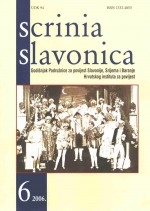Osnivanje i djelatnost četničkih udruženja na području grada i kotara Osijek u monarhističkoj Jugoslaviji (1918.-1941.) (Drugi dio)
Establishment and activities of chetnik associations in the Osijek city and district in the Monarchy of Yugoslavia (1918-1941) (Part 2)
Author(s): Zdravko DizdarSubject(s): History
Published by: Hrvatski institut za povijest
Keywords: Kingdom of Serbs; Croats and Slovenes / Kingdom of Yugoslavia;; chetnik organizations; Osijek; Osijek district.
Summary/Abstract: Ever since its establishment, the chetnik association, as well as the greatserbian politics at large, included Osijek and the Osijek district within the sphere of their interest. This was not so surprising given that Osijek and its district, as well as all of Slavonia, had always been deemed a part of their myth of Great Serbia. Their attempts to make the myth a reality met with unfailing support of the ruling Serbian expansionist circles, primarily of those from the Radical and the Democratic Party camp, who were the founders of the first chetnik associations in the first place. The administrative partitioning of the Osijek district (extraction of the western areas and foundation of the special Valpovo district) was orchestrated to produce a relative Serbian majority in the newly founded district area. Moreover, after subsequently taking over the government over the new district, they also maneuvered themselves into positions of power in the city of Osijek, which they gradually had to abandon following the 1938 elections and the creation of the Banovina of Croatia. These changes were best reflected in the political trends, and especially in the election results of the time. The chetniks also had a special mission to complete in the Osijek area, given its nationality structure (Croatian and other non-Serb peoples’ majority) and geographical position (along the rivers Drava and Danube, a point of convergence of North-South and East-West traffic routes, but also a link between the Serbs in the East in Vojvodina and Serbia, via the Danube border and the Danube bridge close to Erdut, with those in west Slavonia); the mission was to help the Serbian expansionist authorities first, to suppress the communist movement which had a majority non-Serb membership, especially in Osijek (1920/21), and then, in particular, to suppress the Croatian national movement gathered around the Croatian Peasant Party (HSS), while simultaneously performing a serbisation of the area. As a result of this agenda, eight colonies were established which were populated with about 3.000 mostly Serbian volunteers and where a government was established over which the greatserbian parties had a firm hold until they were forced to relinquish the power following the 1938 elections and the establishment of the Banovina of Croatia.
Journal: Scrinia Slavonica
- Issue Year: 2006
- Issue No: 6
- Page Range: 342-401
- Page Count: 60
- Language: Croatian

